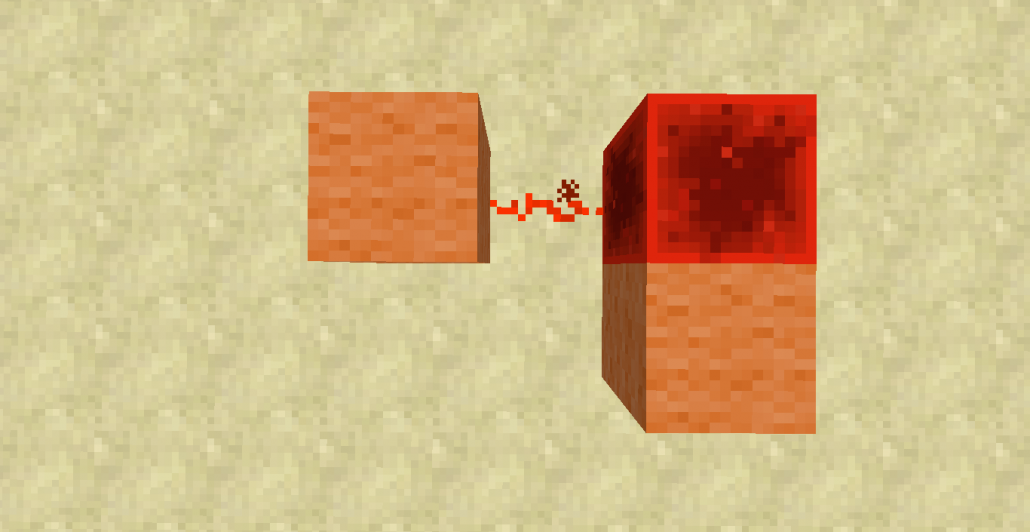Interactions
We call anything that happens due to redstone power a redstone interaction. Many different, some very complex mechanics arise from redstone, too many to cover here. Quasi-connectivity (BUDs) and circuits based on comparators, slime blocks or command blocks will be explained in a later section of this tutorial. This is just a gentle introduction.
Strong and weak power
One of the most basic things you can do with redstone is powering a block. A block is said to be:
- strongly powered if it is directly adjacent to a power source or a repeater or comparator is pointing directly into it with no space in between. Strongly powered blocks will power redstone dust adjacent to them, and will power any redstone components such as redstone lamps adjacent to them.
- weakly powered if it has just redstone dust pointing into it. Weakly powered blocks will not power redstone dust adjacent to them, but will power any attached redstone components.
A signal may be taken from a weakly powered block and extended by placing a repeater or comparator facing out of it.
Other components
Redstone can activate or deactivate an entire suite of Minecraft components. The following is not a comprehensive list, but it should give you an idea.
- All doors, trapdoors and fence gates will open when powered and close when unpowered. Specifically the iron door cannot be opened without using redstone power.
- Normal and sticky pistons will extend when powered and retract when unpowered. It is possible to modify piston behaviour slightly using 0-tick redstone, covered later on.
- Dispensers and droppers will release a randomly chosen item when powered. If the item inside a dispenser is a bucket of water or lava, the first pulse will create a source block adjacent to the dispenser’s exit and leave an empty bucket behind – the next pulse will fill the bucket back up and remove the source block. Note droppers will just drop the full bucket item.
- Note blocks will release a sound at a pre-configured pitch every time they are powered.
- Powered rails will boost a minecart in the direction of travel up to a maximum speed of 8 metres per second.
- Command blocks with the option “Needs redstone” active will execute their command when powered. In the case of repeat command blocks, they will keep executing every redstone tick until redstone power is off.
- A redstone pulse will prime TNT (make it ready to explode).
Flowing blocks
Water and lava are currently the only liquids or fluids in Minecraft and as thus are the only blocks considered “flowing blocks”. Water currents will extend 7 blocks from the source block (exclusive) and lava currents will extend 3 blocks from the source block (also exclusive). Be careful to build redstone contraptions at least one block further than this from any source blocks on the same elevation.
- If any water flows over redstone dust, even if the flow is the lowest possible, it will destroy the redstone dust and make it drop as an entity, which will remain ready to be picked up for the next five minutes, as entities usually do. The flow will, of course, carry this entity to the termination point of the current.
- If lava flows over redstone dust it will destroy the redstone dust and will not make it drop as an entity (note the drop is not also destroyed by the lava, it just does not generate).
Falling blocks
As you probably know, there are very few blocks in Minecraft affected by gravity.
- Sand, red sand and gravel can be placed (apparently floating) on redstone dust in an arbitrarily large stack – however, if the bottom block is broken, all other blocks will fall and break on the redstone dust leaving it unscathed, as is the case with every block which is less than a metre high.
- Anvils, however, even though they can be stacked on redstone, will break it without generating an entity that you can pick up when the bottom anvil is broken.
As a final note, redstone dust placed on a block will break if you remove that block or move it with a piston.

